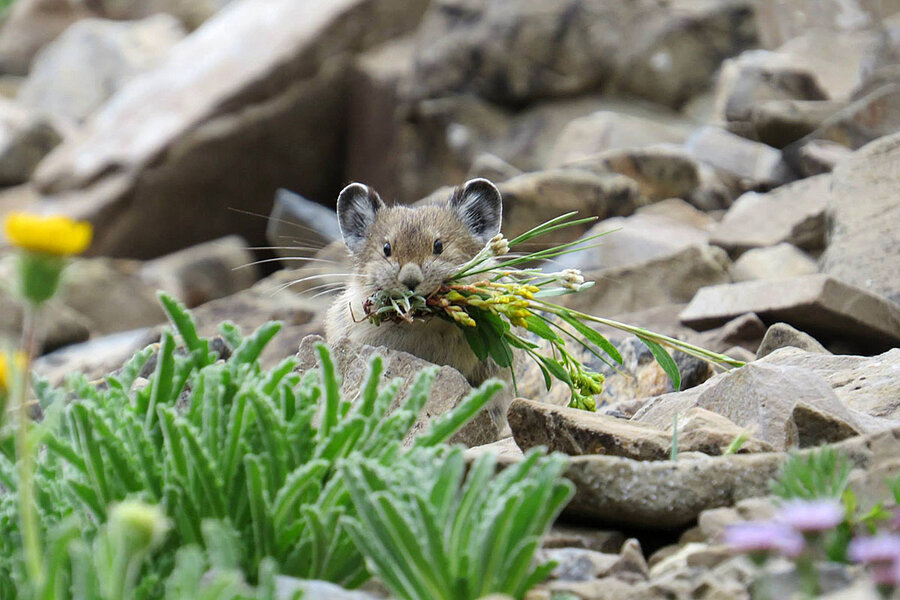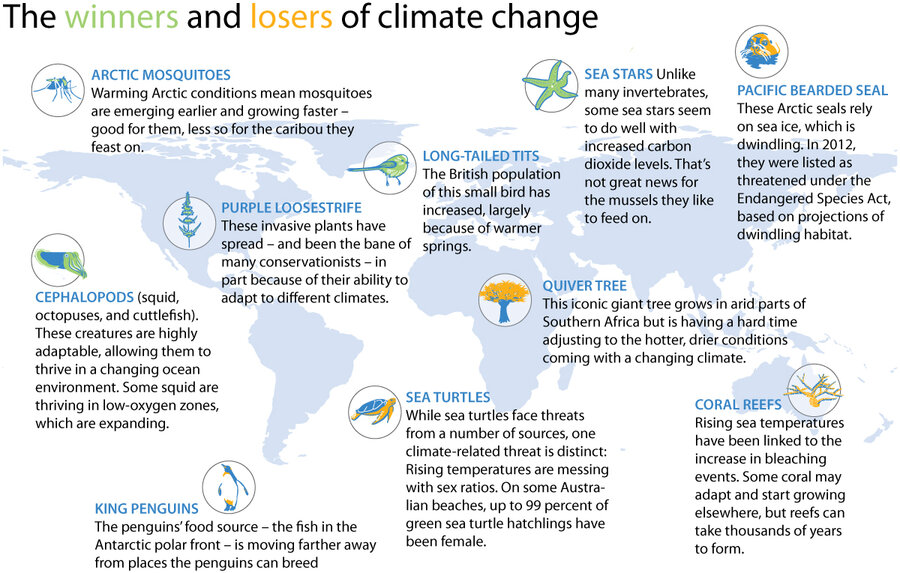For wildlife, climate change brings a mixed bag
Loading...
| Boulder, Colo.
When it comes to plants and wildlife, the effects of climate change may not be as straightforward as they once seemed. For decades, biologists have projected that there will be winner and loser species. But the reality is “much more nuanced than that,” says Erik Beever, a research ecologist with the United States Geological Survey. While many ecologists believe we’re in the midst of a sixth major extinction, scientists are only beginning to understand the role climate change is playing in that process, or just how plant and animal species are adapting to seasonal and climatic changes. In some cases, certain species are benefiting. Other species are showing a remarkable ability to change behaviors, shift their geographic range, or even evolve more rapidly than was thought possible. “We are seeing it happen in front of our eyes,” says Malin Pinsky, an evolutionary biologist at Rutgers University. “We are just starting to understand what’s going on.”
Why We Wrote This
Discussions around climate change and wildlife tend to focus on winners and losers. In reality, animals’ responses cross a wide spectrum – with some showing surprising adaptability.
When Erik Beever began studying pikas 25 years ago, to gain insights on how mountain ecosystems are changing, he might have expected the evidence that emerged in many alpine habitats: As climates grew steadily warmer and drier, numbers shrank and some areas lost their pika populations entirely.
What was more surprising was what he saw in the Columbia River Gorge, a wet, lush region in northwest Oregon. Pikas there are developing different traits from those in the rest of their range. They’re moving off their traditional talus fields, changing their diets, expanding their range down almost to sea level, and are generally thriving.
“Over the last 20 years, people have talked about species being climate-change winners and losers,” says Dr. Beever, a research ecologist with the United States Geological Survey. “But it’s more nuanced than that.” Species’ responses can vary drastically in different geographic and climatic contexts. “There’s a not a simple algorithm or simple formula that we could sum up in one eight-word phrase.”
Why We Wrote This
Discussions around climate change and wildlife tend to focus on winners and losers. In reality, animals’ responses cross a wide spectrum – with some showing surprising adaptability.
While many ecologists believe we’re in the midst of a sixth major extinction, scientists are only beginning to understand the role that climate change is playing in that process, or just how plant and animal species are adapting to seasonal and climatic changes. In some cases, certain species are benefitting. Other species are showing remarkable ability to change behaviors, shift their geographic range, or even evolve more rapidly than was thought possible. The species that may be the most at risk are those with limited ability to change.
“If you look back through biogeography, and other extinction drivers, you can predict that it’s going to be those species that are endemic, or only found in a few places, that have really specialized requirements,” that are the most at risk of disappearing, says Julie Lockwood, an ecologist at Rutgers University in New Brunswick, N.J.
But not all species have such specific requirements. Many of the plants and animals that thrive in suburban and urban environments – think dandelions, robins, coyotes, or deer mice – have already demonstrated a strong ability to adapt that could carry them through climatic shifts. And for invasive species, changes in climate can actually create opportunities to become established in a new environment.
One way that species adapt to changing climates is by shifting their phenology, or seasonal timing of events. Certain species seem to do that better than others. “There are fairly clear patterns that some of the species introduced from other countries are the most flexible in their ability to get up and go in the spring in advance of native species,” says Theresa Crimmins, assistant director for the USA National Phenology Network which, among other things, runs a widespread citizen science project called Nature’s Notebook to help understand the ways in which seasons are shifting. “That’s one explanation for why some of these introduced species are becoming more dominant.”
The power of adaptation
Many biologists project that climate change will ultimately contribute to a shrinking of biodiversity overall. In some locations, however, the number of species may actually rise, particularly since warmer habitats tend to support richer biodiversity. But some species are more flexible than others, occasionally in surprising ways.
Beever notes that there are three main vehicles for adaptation: evolution, flexibility in terms of morphology or behavior, and the ability to colonize or disperse in different areas.
Already, he says, some fish and amphibians are evolving higher temperature tolerances. Stickleback fish, a family of fish whose evolutionary characteristics lend themselves to study across disciplines, have been able to adapt to temperature changes in less than a couple decades. “We thought that wasn’t even possible, for species with such long generation times,” says Beever.
The ability to change the timing of events may be the most common adaptation. Some birds are shifting their migration patterns, and plants are flowering earlier, as they adapt to shifting seasons. One study that looked at plant species around Concord, Mass., over 150 years, based in part on the detailed records that Henry David Thoreau kept, found that plants, like knotweeds, that were able to track temperature changes and shift seasonal timing had done fairly well, while those that remained more rigid in their timing – including anemones, orchids, and dogwoods – were decreasing in abundance.
And while numerous studies show species shifting their range northward, or higher in altitude, not all plants or animals are able to do so. For polar species dependent on sea ice, for instance, there may not be a good substitute. Alpine species may have a hard time moving to a different range.
Those creatures with perhaps the easiest ability to migrate are ocean species, and researchers say that is already playing out.
“We’re seeing hundreds, if not hundreds of thousands, of species shifting toward higher latitudes,” says Malin Pinsky, an evolutionary biologist at Rutgers who studies marine life. “It’s happening about 10 times faster in the ocean as on land, and it’s largely unseen.”
In the Northeast of the United States, that’s meant rapidly declining Atlantic cod populations – a result both of overfishing and warming ocean temperatures. On the other hand, says Dr. Pinsky, species like black sea bass, summer flounder, and spiny dogfish are now thriving in those areas.
In some cases, he says, these shifts may even have geopolitical ramifications. When mackerel moved north into Icelandic waters, disagreements about how to share the new populations led to a trade war between Iceland and the European Union, says Pinsky, and may have contributed to Iceland’s decision to drop its bid to join the EU.
And he and others emphasize that scientists are only beginning to understand the ways in which these climate-based shifts are playing out, and which species will manage to adapt.
“We are seeing it happen in front of our eyes,” says Pinsky. “And we are just starting to understand what’s going on.”









